Making a Concave Mirror
Making a Concave Mirror Using 15th Century Technology
I decided to see if I could make a suitable concave mirror using only technology that would have been available in the 15th century, with the goal of producing a “mirror lens” of the specifications we calculated from Lotto’s painting (i.e. ~54 cm focal length and 2.5cm diameter). Although most people automatically assume a “mirror” must be made from glass, I made these from metal. Metal is much softer than glass, so it is easier to grind, and when completed the surface is automatically reflective without requiring a coating of any kind.
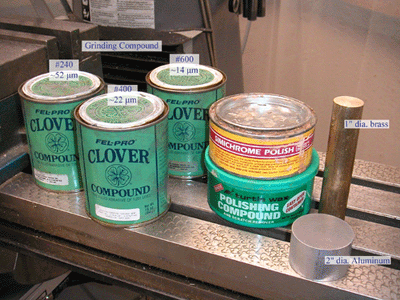
Figure 1 shows the entire set of technology I used: five grades of grinding/polishing compound along with pieces of metal. Nothing more. Historians tell us that artisans were grinding glass spectacles by the 14th century, so they certainly had abrasive compounds at that time.
It turns out that if you rub two bars of metal (or pieces of glass) across each other with grinding paste in between, one surface naturally ends up convex, and the other concave. The reason is that when the pieces aren’t directly over each other the same amount of downward force exerts a greater pressure on the portions that are still in contact, causing more material to be ground away at the edges of one piece to produce a convex surface, and from the center of the other to produce a concave surface. A focal length of 54 cm corresponds to a radius of curvature of 1.08 meters, so there is very little difference between the final concave mirror and a flat surface (the deepest part of the depression is (0.2 mm below the outer edges for a 2.5 cm diameter mirror).
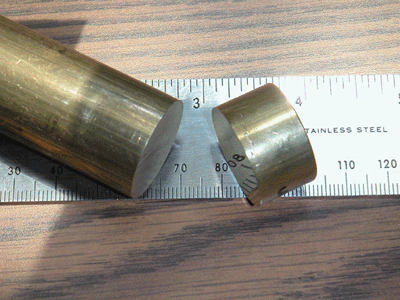
The ruler seen reflected by the concave mirror to the right in Figure 2 makes it appear as if the mirror actually could be flat. It nearly is. The end of the bar to the left is the final convex surface that resulted from the process that made the mirror on the right, which also looks in this photograph as if it could be flat (there was no reason for me to polish the convex surface, which is why it is matte).
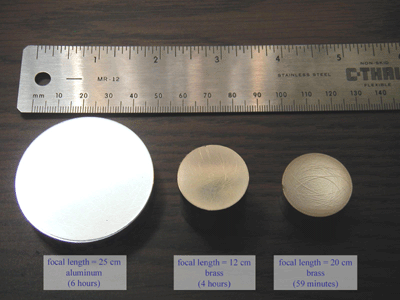
On the left in Figure 3 is our first attempt to make a mirror. My group’s research specialist, Ross Potoff, spent the first three hours on it, after which I took over to finished it. Since we didn’t know what part of the process might turn out to be critical, we were very careful throughout, ending up spending 6 hours to grind and polish this first, 5 cm-diameter aluminum mirror (nb. “grind” and “polish” are qualitative terms for the same thing, depending on whether coarse or fine paste is involved). The focal length ended up being half that of Lotto’s lens, which means we ground away more material than we needed to. That is, we could have spent less time on the grinding process and made a mirror of even longer focal length. This first aluminum mirror projects a very nice image.
I then decided to make a second mirror that was only 2.5 cm in diameter, corresponding to the size we calculated Lorenzo Lotto used. I decided to use brass rather than aluminum to see how much color it would impart to the projected image. As can be seen from the caption under the middle mirror on Figure 3, I ended up producing one with an even shorter focal length than the first one. The reason for this was that since the diameter of the second mirror is only half that of the first, the same downward force when grinding the surface corresponds to 4 times the pressure,. Again, I could have produced an even longer focal length mirror had I spent less time. This second mirror also projects a nice image.
From the first two mirrors I now knew I could spend much less time on the grinding process than I had been. Also, having determined that the projected images from the first two mirrors were of good quality meant I could take somewhat less care and still get a decent image. I happened to start producing the third mirror right at the top of the hour, and a half-hour later noticed I had made considerable progress already. I decided then to see what quality of an image I could get from a concave mirror made in less than one hour. Because I then started rushing I didn’t clean the surfaces as well as I should have when moving from one grade of polish to the next, finer one, and toward the end I quickly jumped to the final polishing stage in order to meet my self-imposed one-hour deadline. It can be seen from Figure 3, the surface of this “59-minute” mirror has large scratches that are quite obvious. However, in spite of this being my worst mirror, I used it for projecting the image in Figure 4.
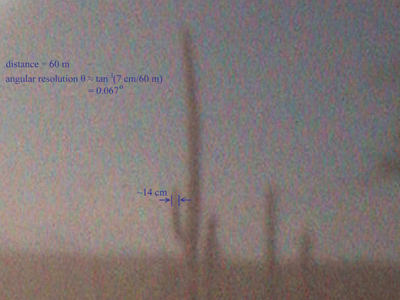
Figure 4 shows an enlargement of a small portion of the image projected by my worst, “59-minute,” concave brass mirror. The brass imparts only a small amount of reddish hue to this image for reasons I won’t take the time to explain now. The mottled background is an artifact of the resolution of the digital camera I used to photograph the projected image (this is an enlargement of only a small portion of the photograph). I then used a rangefinder to determine the cactus was located 60 meters away, and measured the diameter of an arm of a saguaro to be ~14 cm. Note that it is easy to resolve the 14 cm arm from the adjacent ~18 cm trunk on the projected image, which means that two vertical bars of width ~7 cm that were located ~7 cm apart would be resolved at that same distance. From this measurement I am able calculate the angular resolution of my “59-minute” brass concave mirror to be at least 0.067 degrees.
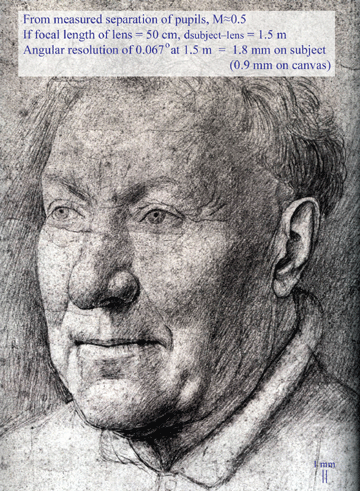
Figure 5 shows the significance of the preceding 4 images and the measurements made from them. From the measured separation of the Cardinal’s eyes on van Eyck’s drawing, and the fact he is viewed at an angle of ~30 degrees to us, I calculate that this drawing was made at approximately 50% of life size. If van Eyck had used a lens of 50 cm focal length (i.e. one comparable to Lotto’s) to aid him in making this drawing, we can calculate from the Lens Makers’ Equation of geometrical optics that the Cardinal would have been sitting 1.5 meters from the lens. If van Eyck’s lens had had only had the angular resolution of my worst, “59-minute,” brass concave mirror, this means that laugh-lines on the Cardinal’s face that were 1.8 mm apart on the Cardinal himself would have been resolved. Since the drawing is at 50%, this corresponds to only 0.9 mm on the projected image. The 1 mm scale at the lower right of this drawing shows that such a resolution would have been sufficient for van Eyck to have made this drawing from an image projected by such a lens.
To summarize, using only grinding paste and pieces of aluminum or brass, it is quite easy to fabricate concave mirrors of suitable focal length, diameter, and resolution for 15th century artists to have used to project images.

